Nowadays, due to the heavy influence of social media and celebrity culture, the modern hair beauty standards have become associated mostly with the lustrous, red-carpet-ready, natural and elegant hair look that most of us have seen celebrity’s public appearances and social media posts. Under that influence, more and more women are leaning toward buying hair extensions, as a way to elevate their natural hair beauty and achieve their desired, naturally gorgeous hair look.
However, as hair consumers yourself, it is inevitable to feel confused with the existing diverse hair extension types in the market, as well as unsure about their lifespan and whether they would be a suitable candidate for your specific hair needs and frequency of hair use. In this article, we will go over all the information regarding each and every individual hair extension types’ lifespan, maintenance and application methods – answering the questions: How long do hair extensions last.
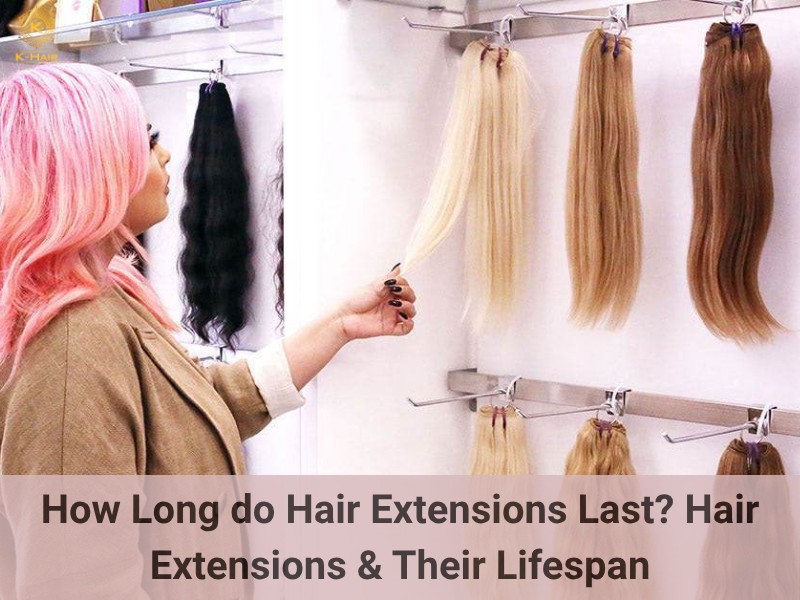
1. How long do hair extensions last?
By definition, hair extensions are cosmetic hair items, often recommended by hair professionals and medical practitioners as a way for users to add natural volume, length, and highlight color to their original hair look – solving hair problems such as balding, thinning hair,… The most popular hair extension types in the market might include: hair wefts, tape-in, clip-in, Keratin bond and I-tip extensions,…
Regardless of the differences in application method and construction between different hair extension types, all the above hair items tend to share the same lifespan range: from 6-12 months. However, the individual lifespans for different hair extension lines would vary greatly, due to their application, usage and reusability, as well as other fundamental features such as hair quality and hair types,… Nevertheless, such a number can still be extended for many cases, especially when the hair users know how to take proper care of their hair products and push back signs of quality deteriorating .
Given the varied and different hair lifespan offered for different hair extension types, hair users, when shopping for such items in the market, would need to take careful consideration of their longevity and lasting time for each application of the hair extension, and make well-grounded purchasing decision based on their own hair needs and frequency of use. By doing so, hair buyers can get for themselves the most suitable and convenient hair extension item that best aligns with their personal hair interests, helping buyers understand how long do hair extensions last depending on the type and care routine

2. The Lifespans of Different hair extension types
Nowadays, thanks to the development of technology and the influence of social media, more and more hair extension variations are being introduced to the market, satisfying the rising and complex hair demands. Hence, when answering the question: how long do hair extensions last, giving a vague, general answer is rarely ideal and helpful, as the aforementioned lifespan would range greatly from different hair extension types and their application methods. Therefore, before delving into each and every hair extension types and their longevity, readers can first take a look in our brief breakdowns below:
| Hair extension types | Longevity | Key features |
| Hair wefts (sew-in hair extensions) |
|
Is widely used in the sew-in method – where the stylist will directly sew the bundle into the user’s hair using braids as base |
| Tape-in hair extensions |
|
Features a strip of adhesive at the root, can add instant volume to the hair without needing professional help – while still secure long-term hair use. |
| Clip-in hair extensions | Overall longevity: 6-12 months | Offer the fastest, most convenient application method → extremely suitable for daily hair use |
| Keratin bond extensions |
|
Feature a keratin head at one end – can be melted using tools and be attached to the wearers’ hair as adhesive. |
| I-tip hair extensions |
|
Much like the keratin bond extensions, but instead of being attached by adhesive, I-tip hair can be applied using micro ring, rubber tubes. |

2.1. Hair wefts and their Lifespan
In terms of lifespan, or essentially, how long do hair extensions last when using wefts, this option is considered one of the most durable. Hair wefts, also known as hair bundles, are an extremely popular hair extension type in the market – especially in the African American hair community. Upon first impression, hair wefts consist of hair strands of similar length, gathered and sewn into one consecutive strip, before being folded into bundles. This special hair extension types is often used as the main ingredient needed for the sew-in hair application method, where the stylist will braid the clients hair into rows, and use such braid lines as a base to sew in the hair wefts – a special hair application method widely-used by African American hair stylists. After a few hours of sewing, the hair wearers can enjoy a long-lasting, durable and voluminous new hair look, which can last up to 1-2 months before needing reinstallation. Furthermore, the lifespan of hair wefts is also among the highest compared to other hair extension counterparts. In fact, under proper care, a high-quality hair weft extension can even last for 1-2 years or more – making it a worthwhile hair investment, extremely for those looking for durable, long-lasting hair solution.
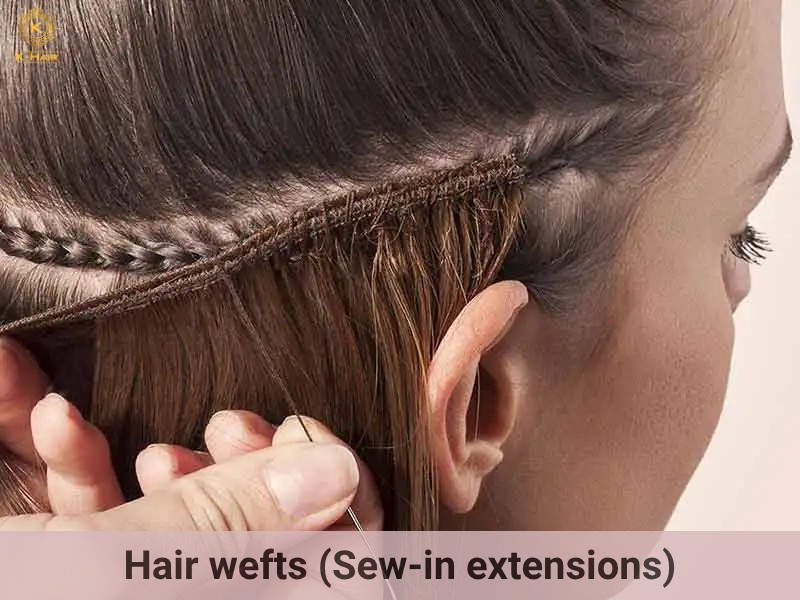
For hair users planning on buying hair wefts for personal uses, it is highly suggested to go through some of its benefits and drawbacks stated below:
- Cheap pricing: hair weft is among the most basic hair extension types out there. Indeed, for production, this specific extension line is often the least complex and technologically demanding of all the existing lines in the market, hence, in terms of pricing, hair wefts are also the most affordable and widely available among the category.
- Long-lasting & Durable final look: using hair wefts as extensions, clients can enjoy the final hair look for as long as 1-2 months, before having to schedule for a reinstallation. Especially for active hair users, wanting hair extensions that can match their active, sporty lifestyle, using sew-in hair extensions can be the perfect candidate, thanks for their durability.
- Lengthy application time: hair wefts and their sew-in application are often done in a salon surrounding, as these products are extremely time-consuming and require special techniques to be properly installed to the original hair. Furthermore, the installation would often include extra steps, such as washing, detangling, and braiding → making the average installation taking up to more than 3 hours to finish.
- Not suitable for extremely thinning: in order to install the hair wefts onto the end-users’ hair, their hair would be braided first into rows to be used as sewing base for the hair bundles. This process often results in more pressure being applied to the original hair and scalp, potentially causing the existing thinning hair condition to be worsened – damaging the user’s real hair and scalp.
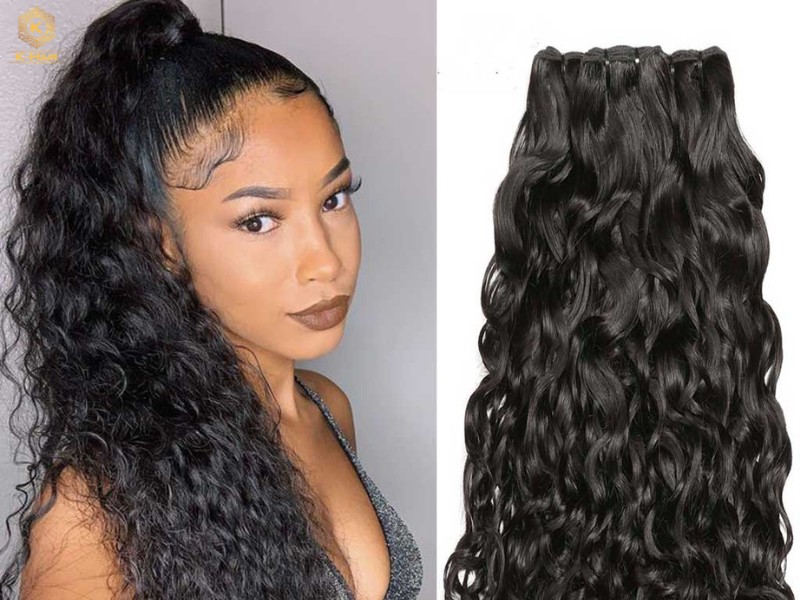
2.2. Tape-in Hair extensions and their Lifespan
Throughout the years, tape-in hair, alongside other variations in the market, has become one of the most sought-after hair solutions out there, mainly for its lightweight and natural look. Most tape-in hair extensions offered in the market share the same construction: small weft hair consisting of a small strip of double-sided adhesive at the root of the weft. Once the protective seal of the tape is removed, the product can be applied directly onto the hair, without demanding the assistance from professional tools or stylists.
For these specific hair items, the answer to the question “how long do hair extensions last?” would be from 9-12 months or more, with each application lasting up to 1-2 months before needing reinstalling. Hence, when compared its longevity to other hair extension counterparts, Tape-in hair takes great pride in being one of the most long-lasting options, becoming a worthwhile long-term hair investment for all hair buyers in the market.

For hair users planning on buying tape-in hair extensions for personal uses, it is highly suggested to go through some of its benefits and drawbacks stated below:
- Natural blend into the user’s hair: tape-in hair extensions often come in flat, small wefts, with a thin strip of adhesive at the root. Such flat and delicate appeal helps tape-in hair to blend in almost seamlessly into the natural hair line of the users – adding instant volume and fullness to the hair without causing awkward bumpiness.
- Reusable: one major perk of using tape-in hair extensions is that they can be reused multiple times. Indeed, once the adhesive wears off, the users would just simply retape – replacing the tape of the extensions and the product would be as good as new.
- Offer more convenience: unlike other professional salon extensions, tape-in hair is extremely user-friendly and can be applied to the user’s natural hair without needing expensive salon visits. Furthermore, its application does not require lengthy waiting time either, as for many cases, the hair wearers often only need to spend one hour or slightly more to complete the application themselves.
- Extremely high-maintenance: tape-in hair does not acquire the firm, long-lasting grip of the normal keratin bond extensions or the hair wefts. The adhesive end used for attachment in tape-in hair is extremely heat and water sensitive – easily becoming looser or more prone to slipping if exposed to high heat or chlorine-ridden water for an extended period.
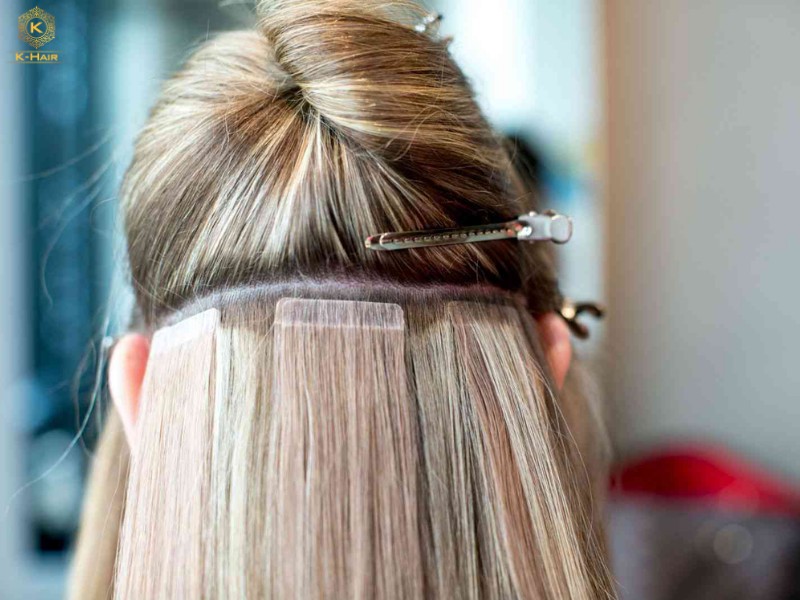
2.3. Clip-in hair extensions and their lifespan
When customers ask how long do hair extensions last, clip-ins fall into the medium longevity category. To better satisfy the complex hair demands, as well as infusing hair extensions into the busy lifestyles, clip-in hair extensions are invented, as a modern, convenient hair solution for all hair users in the market. Clip-in hair extensions often come in layers of small hair wefts, featuring small, tiny hair clips at the root of the items – which allow the extensions to be attached to the user’s original hair and add instant volume to their hair look.
In the market, clip-in hair is often regarded as a medium-range hair extension in terms of longevity, as it can last up to 6-12 months, greatly depending on the frequency of use and hair quality involved. However, one special thing about clip-in hair is that they offer a temporary hair extension use – meaning that, unlike other options in the market that last 1-2 months for each application, clip-in hair can be used freely, and conveniently. Indeed, taking only seconds to be applied and uninstalled from the user’s hair, clip-ins allow more freedom and convenience for its wearers, making it the go-to hair extension options to wear on the daily, extremely suitable for hair users with busy schedules or less time to spend on daily hair styling.
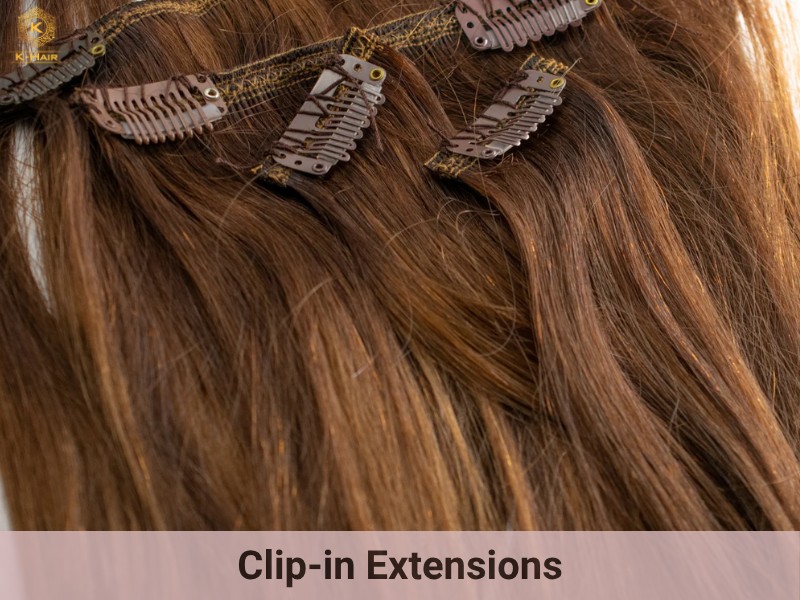
For hair users planning on buying tape-in hair extensions for personal uses, it is highly suggested to go through some of its benefits and drawbacks stated below:
- Fast installation & Versatility: small clips featured in clip-ins take only seconds to be attached to the wearer’s hair → making it extremely easy to be applied and taken off. Hence, for hair users wanting quick hair transformation or daily volume addition, clip-in would definitely be the perfect candidate.
- Non-damaging application: clip-in hair extensions are among the rare extension choices that can be considered as 100% scalp-friendly out there. Indeed, it does not require extensive preparation like the hair wefts, or heat, glue, tape attachment like the keratin, tape hair, hence, clip-in would not deal any damage to the user’s original hair → making it the safest extension option.
- Less natural: clip-ins, unlike other hair extension options, cannot guarantee entirely natural blending ability, especially for hair users with extremely short, thin hair. Furthermore, if done improperly, clip-ins can leave out awkward bumpiness that cause the hair to look inauthentic or unappealing.
- Potential slippage: for hair users with smooth, silky or thick hair, using clip-ins might not be the ideal solution, as the small clips could only provide a weak grip onto the user’s hair. In such cases, the hair clip can easily slip off from the user’s hair throughout the day, causing embarrassing or uncomfortable situations.
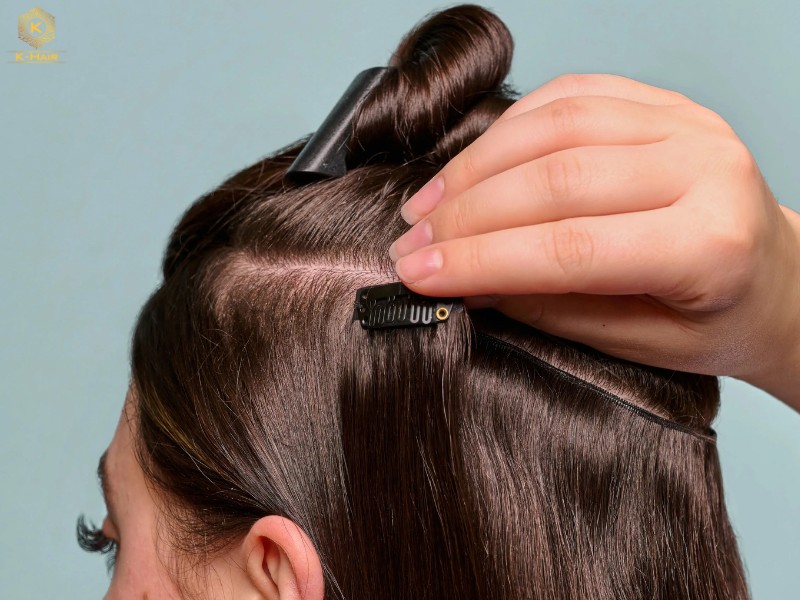
2.4. Keratin bond Hair extensions and their Lifespan
Thanks to the advancement of technology made in the hair production industry, modern, convenient and advanced hair products have been introduced to the market. One of those most professional hair solutions in the market is indeed, the keratin bond hair extensions, widely in favour of many hair buyers out there. By definition, keratin bond hair extensions are extremely small, even tiny hair extension products, featuring a heat-activated keratin end at the root. In order to attach the hair onto the user’s head, the stylist would have to use a specified hair tool to induce heat and melt the substance into an adhesive, and glue it with small sections of the hair.
But how long do hair extensions last when attached with keratin bonds? For this particular hair extension option, the lifespan would be from 3-6 months, somewhat inferior compared to other extension types in the market, whose lifespans range from 6-12 months. Additionally, for each application, the average lifespan would be from 3-4 weeks, or slightly more than 1 month, hence, when using keratin bond extensions, the users might have to expect more frequent salon visits to remove or reinstall the hair extensions.
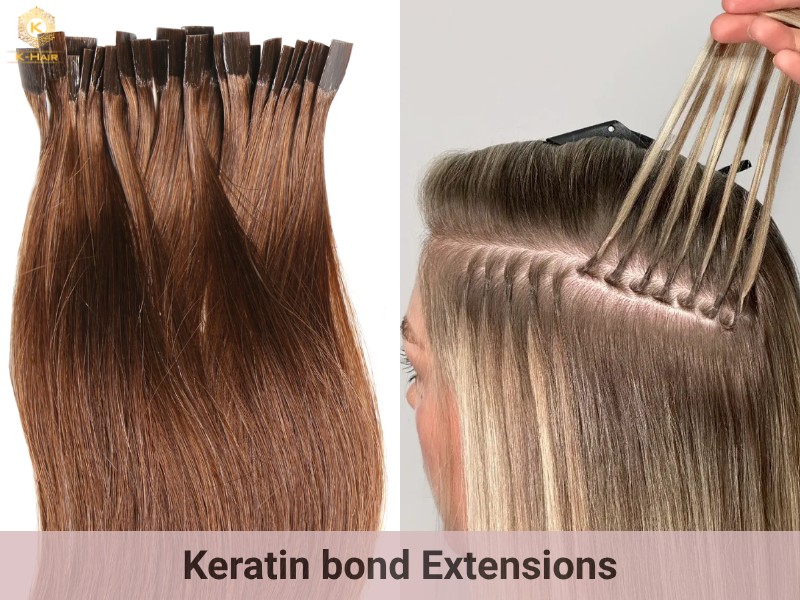
For hair users planning on buying tape-in hair extensions for personal uses, it is highly suggested to go through some of its benefits and drawbacks stated below:
- Natural hair look: keratin bond hair extensions are extremely lightweight, and can be attached to small sections of the hair, meaning that the hair extensions will give the hair a natural, effortless hair look, with natural and flexible movement following each and every of its users’ moves. Furthermore, by being attached by small hair sections, keratin bond hair can blend in extremely well into the wearer’s natural hair volume, adding more fullness without making it seem awkward.
- Styling versatility: following its seamless blend is its ability to allow more versatile styling options. Indeed, when using keratin hair, the clients can have more freedom to straighten, curl, or style the hair to their own liking – much like our own hair.
- Higher price: due to being one of the most innovative and advanced hair products in the market, keratin hair often requires more resources, labour and technology to produce, and hence, is often placed at a higher end of the pricing range. In fact, keratin hair extensions are often the most expensive hair extensions in the market.
- Lengthy application time: because the hair must be attached and applied in small hair sections, the entire application process can be extremely time-consuming and lengthy, often taking 2-6 hours to finish. Furthermore, these specific hair products can only be applied using the help from hair specialists and professional tools to be installed into their user’s head, making this product highly dependent on salon service.
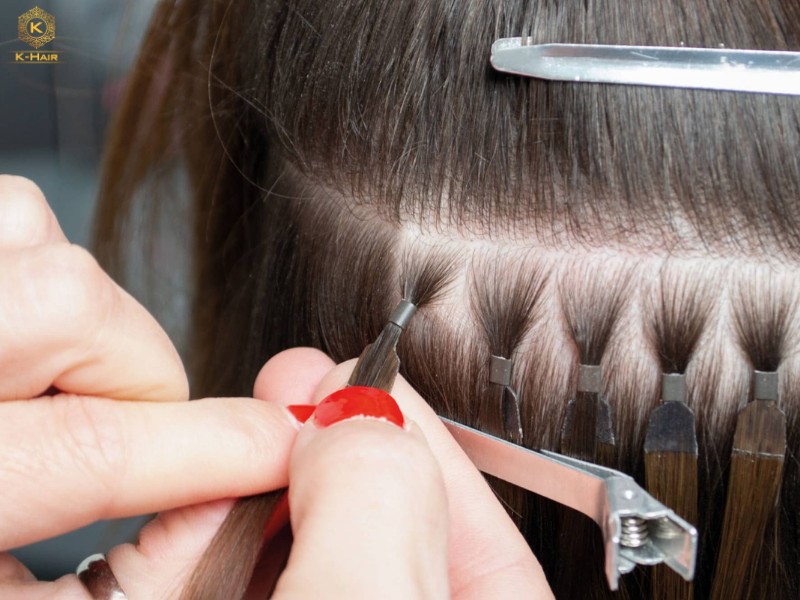
2.5. I-tip Hair extensions and their Lifespan
I-tip hair extensions derived from keratin bond extensions, and much like its original, I-tip hair also feature a keratin head at the root of its piece. However, instead of being attached to the hair using heat to melt the keratin and glueing it to the wearer’s hair section, I-tip hair is applied by tying to the hair using tiny rubber rings or tube – creating a non-damaging hair extension option. For buyers questioning how long do hair extensions last in micro-ring formats, I-tips generally offer comparable longevity to keratin bonds. In terms of lifespan, the longevity of I-tip hair is actually quite similar to that of typical keratin bond extensions – can be used for 3-6 months, with 3-4 weeks for individual application.
For hair users planning on buying tape-in hair extensions for personal uses, it is highly suggested to go through some of its benefits and drawbacks stated below:
- Non-damaging hair application: unlike the traditional keratin hair extension, I-tip hair does not require heat, glue, or any type of adhesive to be attached to the wearer’s original hair, hence, it is situated among the most non-damaging hair extension options in the market.
- Reusable: dissimilar from the classic keratin hair extensions, I-tip hair can easily be reused, cleaned, adjusted and reinstalled multiple times, without affecting the actual quality of the hair.
- Potential discomfort: however, if done improperly, I-tip hair might be attached too close to the wearer’s natural scalp, which can potentially cause intense irrigation or hair falling out. Furthermore, in the above case, when the tube or micro ring is placed too near the actual hair roots, the situation can cause more damage and pressure onto the hair.
- Lengthy application: similar to the keratin hair extension, I-tip hair cannot be properly applied onto the users’ without the help of professional tools or stylists. Hence, for those wanting instant results, the 4-hour wait of salon vist must be paid for the items to achieve its most desirable effect.

3. Signs your hair extensions need replacing
As hair buyers, all women would definitely want hair that can be used for a long, extended time period, in order to make full use of their spent expenses and make a worthwhile investment out of the price they paid. To truly understand how long do hair extensions last, buyers must also look at the major factors that directly influence extension longevity. For hair extensions, these signs are not just a reminder for hair users to replace their own, worn-out hair extensions, but can also deal a negative impact on the overall hair look, making the hair look less and less attractive and appealing.
- Excessive tangling & shedding: one obvious sign that your hair extensions cannot be used any longer is excessive tangling and shedding. This can be a sign indicating that the hair has lost too much of its moisture, nutrients, or their cuticle layers are extremely misaligned, dry and damaged, making the hair more prone to breakage, shedding, and extremely hard to style and maintain an appealing outlook. However, this can also be a sign signifying that the hair extension and the hair quality itself might be of low-quality, making the hair more prone to tangling, shedding, further thinning out its original volume.
- Loss of shine and softness: after an extended period of hair use, the extension might show clear signs of being worn out by losing its original natural hair shine and softness. Such traits can signal that, either the hair is made with synthetic, low quality hair materials and laced or coated with silicon that wear out over time, or that the hair is of authentic quality but still loses its shine due to dehydration, constant exposure to high heat, harsh environment, or chemical-based washing,… As a result, the hair cannot reflect light beautifully as before, and turn coarser, more brittle during touch, affecting the overall hair look.
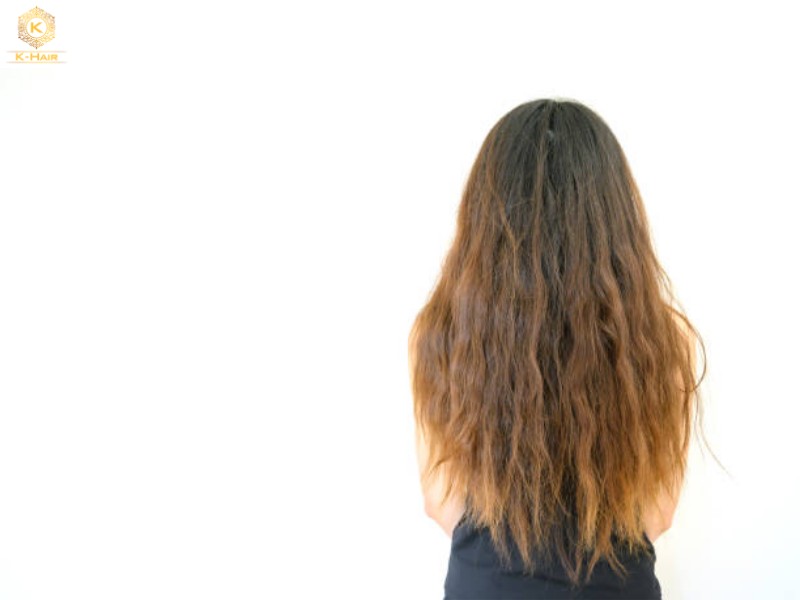
- Physical damages: physical damages in the construction, features of the extensions might also be a sign to rush to the store and buy yourself a brand new piece. For reusable hair products, such as tape-in, i-tip hair, if any damage is done to their tape or micro ring,… the hair buyers would easily replace these features, however, for other products, such as hair wefts, keratin hair extensions, whether if the weft is cut or ripped apart, or that the keratin head is pre-used or broken, the hair buyers would have to purchase brand new ones and completely replace the hair items.
- Product buildup: for hair extensions undergone extended using time, product buildup is inevitable, especially for those who frequently style their hair using gel, hair spray, or other chemicals. Hence, after a long time using, the hair might feel heavy, greasy, or heavily coated that make the extensions look dull, lifeless, and causing more hair tangling, especially that the roots of the hair strands. Additionally, for tape-in and other kinds of extension using adhesive, such excessive product buildup also reduces the adhesive functionality, causing more frequent slippage.
- Difficult styling: one major downside of using old, worn-out hair extensions is that they are often extremely difficult to style, straighten, curl, or bleach, limiting its versatility. In fact, this has a lot to do with the hair’s deteriorated cuticle layer, causing more moisture and nutrients to evaporate from the inner core of the hair strands – making the hair more brittle, weaker and coarser, less responsible and flexible for styling. Hence, during styling, the hair would require higher heat and more products in order to achieve the desired outcome, while still failing to preserve such textures for a longer time afterward.
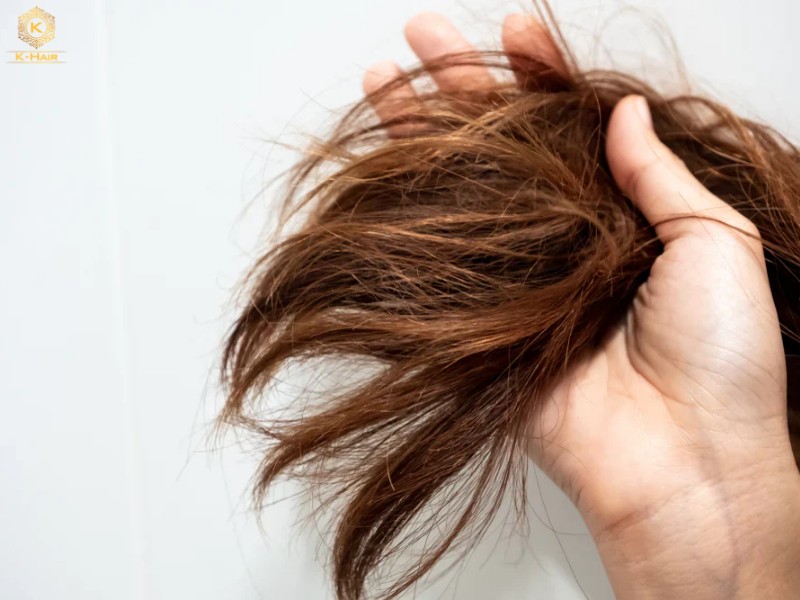
4. Key factors that affect how long hair extensions last
Being informed with signs indicating quality deterioration is rarely enough, rather, if one wishes to make full use of their investment, they should also look into the factors affecting the longevity, or how long do hair extensions last. And hence, through this information, hair buyers can be equipped with the adequate information, as well as avoiding unwanted, detrimental hair habits that might cause their extensions to be worn-out faster.
4.1. Hair types
In the global hair market, there exists four main types of hair, each with their own features, pricing and performance – suitable for different hair preferences in the market. This is also why buyers often ask how long do hair extensions last, since different quality levels naturally offer different longevity. And indeed, their respective lifespan would range between the four hair type options:
- Virgin hair: is the highest hair quality in the market, obviously Virgin hair would obtain the most long-lasting hair lifespan among the four. Collected from one donor only, and kept completely free from any chemical processing, Virgin hair is able to guarantee pristine hair quality and uniformed, aligned cuticle layer for each and every strands → better preserve moisture, nutrients and deliver long-lasting, flexible hair use. For most Virgin hair extensions, the average lifespan would be from 3-5 years or more under proper care.
- Remy hair: being the more widely available hair type, Remy hair can still preserve many desirable traits of Virgin hair, such as softness, silkiness and durability. However, as it is collected from 2-3 donors, Remy hair cannot guarantee the ultimate cuticle alignment seen in Virgin hair, making the hair slightly more prone to tangling and shedding → leading to a short lifespan for hair extensions made from Remy hair. However, for most Remy hair extensions, the average lifespan is still from 2-3 years or more under proper care – showcasing its long-lasting potential and durability.
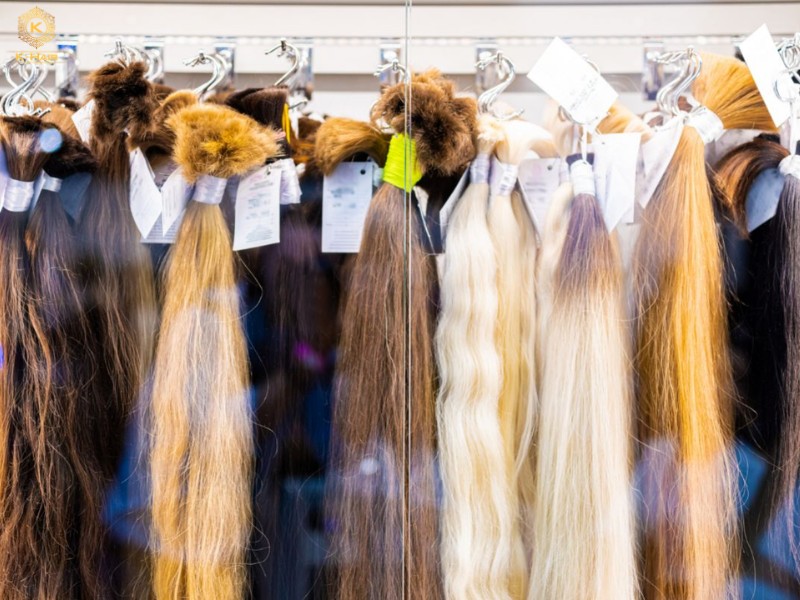
4.2. Non-remy hair
This is the lowest grade of human hair extensions in the market – consisting of trashy, messy, tangled hair collected from multiple unidentifiable hair sources, such as salon floor, trash, side walks, or public bathroom. Due to being collected from such shade sources, Non-remy hair might actually include low-quality, chemically treated hair strands, as well as lacking of the necessary cuticle alignment to protect its original hair health and integrity. Hence, for most Non-remy hair extensions in the market, the items would typically last for 3 months, before showing signs of needing replacement.
4.3. Synthetic hair
This hair type belongs to the non-human category, given that the hair is made entirely from chemical-based, plastic substances, created to mimic the natural hair shine of human hair. However, being made with plastic also means that the hair strands would be extremely coarse, brittle and stiff – limiting its functionality and durability. Much like the Non-remy hair line, most synthetic hair in the market would only last for 3 months or less.
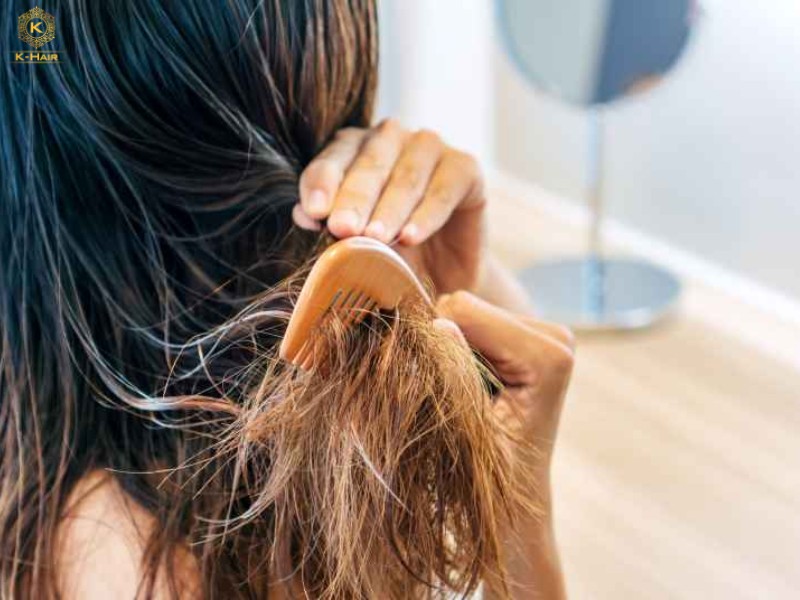
4.4. Application method
The way that the hair extensions are applied or placed onto the user’s natural hair can have a great impact on the extension’s lifespan. Indeed, for professional salon extension options such as I-tip, keratin bond, wefts, or in some cases, tape-in, would be able to guarantee longer hair use time, given that the hair is properly installed, placed in the right direction, or weight distribution can ensure that the hair would be less likely to slip, break, or wear down. Hence, for all the above hair extension categories, it is highly suggested for users to consult and request help from professional stylists, rather than perform the application by themselves.
4.5. Extension types
As previously mentioned, different hair extension types would have a different range of lifespan, due to their differences in purposes, application method. For example, the disposable, non-reusable hair extension options, such as the keratin bond extensions, often come with lower lifespan 3-6 months, compared to other hair extension options, which typically last from 6-12 months. Hence, to make the most well-grounded decision when shopping for hair extensions, buyers must make sure to carefully consider the signature lifespan range of the products they are planning on buying.
4.6. Exposure to heat and chemicals
Much like our own hair, hair extensions tend to be shorter-lasting and more fragile due to exposure to heat and harsh chemicals. Indeed, by constantly subjecting hair extensions to high-heat styling, straightening and curling, not only the process would make the hair get back to its natural textures, but also cause serious damage and dehydration for the hair strands. Furthermore, using chemicals to bleach, style, or treat the hair is rarely ideal either, as the harsh substances used can cause the hair to lose its original pristine hair health, causing even more severe damages, making the hair brittle, lifeless and hence, more prone to breakage and shedding. Left untreated, these issues shorten how long do hair extensions last regardless of the method used.

4.7. Frequency of use
The more you use the hair, the shorter-lasting it would be. Such a tendency is because of the external factors that can potentially affect the wellbeing of the hair. For example, constant exposure to high heat from the Sun would not only subject the hair to dehydration, but also make the scalp release more oil – causing product and material buildup. Furthermore, exposure to chlorine-ridden water from swimming pools would also cause the hair to dry out and weaken its natural hair health. Hence, for those wanting to constantly wear hair extensions, you should expect a slight degree of longevity degradation for those products, and adopting protective methods to better preserve their lifespan.
4.8. Natural hair condition
Unlike many might assume, the natural hair state of our own hair can actually have a certain impact on the lifespans and function of hair extensions. For example, hair users with oily, silky natural hair might expect more slippage when using hair extensions, as their natural scalp oil can not only provide less grip for the hair extension to stay attached, but also causing product, material buildup that causes the hair to lose its shine and functionality overtime.
5. Hair extensions’ Uninstallation
Longevity doesn’t just depend on wear, proper removal also affects how long do hair extensions last and how well they maintain their performance. For different hair extensions, the stylists or the users would have to perform different, distinct and according uninstallation methods. Whether you are a beginner stylist wanting to learn the rope, or a personal hair users wanting to DIY your uninstallation to save money, this part will come to the rescue – providing a tutorial on how to remove different hair extensions the RIGHT way:
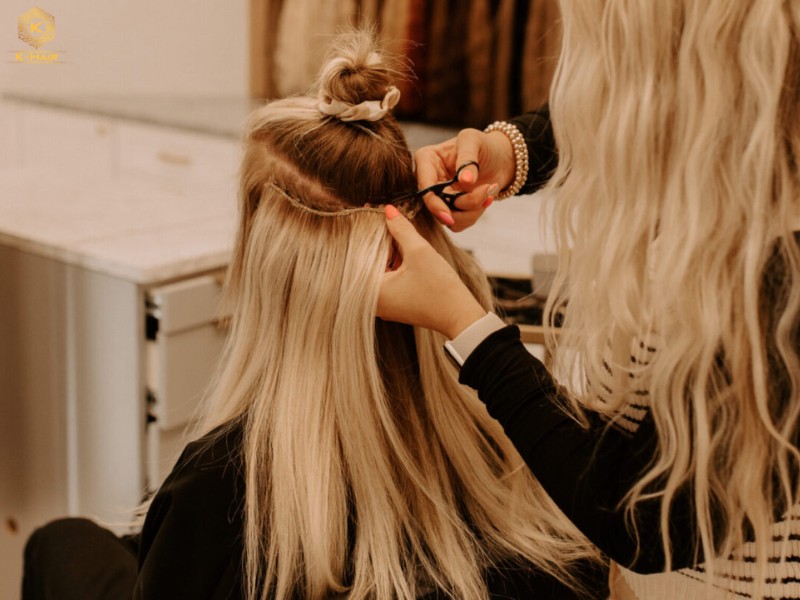
5.1. Clip-in
For clip-ins, the most convenient hair extension option, the removal would be just as convenient and time-efficient:
- First, you can feel around the edges of the weft to reach for the clips
- Once the clips are located, you can press or snap them open to detach the clips from your natural hair
- Gently slide the extension out of your hair. However, be careful, since some hair strands might be caught up in the wefts and hair clips, causing minor tangles and hair shedding if done improperly.
- After taking it off, hair buyers should now lightly detangle the hair extensions and store them carefully in silk hair bags, ensuring minimal tangling while storing the hair.
>>Watch this for tutorial:
Hair To Remove Your Clip-In Extensions
5.2. I-tip extensions
To remove these hair extensions, it is suggested to resort to the help of a professional stylist rather than doing it yourself. Furthermore, to successfully remove I-tips, special tools and equipment are required – as the micro rings or tubes used to attached the hair can be extremely small and hard to remove by hand:
- The stylist would typically start the process by locating, finding the positions in which the I-tips are installed.
- Next, they would use a special tool named micro-ring plier to squeeze the ring or the rubber tube in the opposite direction to loosen it and make space to pick it out and remove it from the small hair section, without causing discomfort or shedding.
- Once the ring is opened, the stylist will use the plier to pick it out and slide it downward and out of their clients’ natural hair.
- After repeating the same steps for different hair sections, and removing all the I-tips from the natural hair, the stylist would now gently detangle the hair using a wide-tooth comb, as well as wash/store the hair to preserve its pristine hair health and reduce buildups.
>>Watch this for tutorial:
How to remove Microring Extensions
5.3. Keratin bond extensions
As it is the most advanced hair extension options in the market, keratin bone extensions would also require just as complicated and extensive tools, assistance. In fact, much like the I-tip, to properly remove keratin bond extensions, the hair users would have to seek assistance from professional salon stylists:
- The first step is much like with the I-tip hair extensions: first, the stylist will try to find and locate the position in which the hair extension is applied on, and use salon hair clip to section the hair out for better observation.
- Next, they would apply a special solution called the keratin bond remover to each tip to make it easier to break, and then, use a special fusion removal pliers to gently crush and break down the keratin bond.
- Then, the stylist would leave out the beads to soften, to remove completely the hair extension from its hair section.
- After repeating the process with other hair sections, the stylist will then gently detangle the hair, combing out any leftover residues and finishing off by washing the clients’ hair to make sure that there are no remaining keratin flakes that might cause discomfort or irritation.
>>Watch this for tutorial:
Fusion Hair Extensions Removal-Glo Extensions Denver
5.4. Tape-in hair
Much like the above hair extension options, to remove tape-in hair, special equipment or tools would be required.
- First, locate the positions where the tape-ins are installed onto the user’s hair, and then use long, firm-grip hair clips to section out the hair for better observation and more effective removal.
- Spray the adhesive removers onto the tape of the extensions, making sure that the solutions are evenly distributed throughout the entire area, and then wait 1-3 minutes for the removal solution to soak in and break down the adhesive.
- Next, separate the tape and slide the extensions off the natural hair. If the hair extensions are still tightly attached to the natural hair, try not to pull the hair, rather, apply more remover and wait for a few more minutes to try again.
- Before moving onto the next hair section, make sure that your hair does not have any residue left at the root that can cause more problems in the future. To be safe, add more remover to dissolve any trace of adhesive left, comb and clear out the area using a wide-tooth comb.
- Once all tape-ins are removed, the hair user can now proceed to wash their hair to completely get rid of any adhesive residue left, or any product buildups that might cause their natural hair to look flat, unappealing.
>>Watch this video for tutorial:
Glo Extensions Denver – Tape-in Extensions Application & Removal
5.5. Sew-in hair extension
Much like its application, the process of removing these hair wefts would be just as time-consuming. In fact, instead of doing it yourself and accidentally cutting into your own hair – a typical mistake for most hair users trying to remove their sew-in by themselves, it is highly recommended to schedule a removal from a professional stylist:
- First, the stylist would have to locate the stitching by finding and feeling along the weft to find the threat which was originally used to sew and attach the hair wefts onto their braided base.
- Next would be cutting the threat, but this part tends to be quite difficult, since most of the time the thread tends to be of the same color and appearance as the clients’ real hair. Hence, for hair stylists, it is best for this step to work in smaller sections first to avoid cutting into the clients’ hair or their braids.
- Removing the wefts would be a piece of cake, as the wefts will automatically loosen itself once the thread is removed. Once all the wefts are removed from the hair, it is now time to unbraid, and detangle the base braids. Normally, to not damage the original hair, this step would be done at a slow pace, making it typically lasting from 1-2 hours to complete.
- After detangling and getting rid of any fallout hair in the process, the stylist would now wash the client’s hair, to make sure there are no leftovers and get rid of any product buildups.
>>Watch this for tutorial:
How to Take Out a Sew in Weave by Yourself
6. How to care for hair extensions to make them last longer
Looking for a way to further boost the lifespan of your hair extensions? This part will provide all the answers you need, as well as tips and advices you might need throughout the maintenance of the products. This routine alone can dramatically extend how long do hair extensions last across all hair types:
- Swimming & Sun exposure: as previously mentioned, constant exposure to the Sun and chlorine water can be extremely detrimental for the hair’s longevity. Hence, to limit such unhealthy influence, hair users can adopt some extra maintenance tips, such as: limiting prolonged Sun exposure by wearing a protective hat or umbrella; wear a swim cap to prevent swimming pool’s water to come into contact with the hair; wet the hair with clean water before jumping into pool or salt water,… By doing these extra steps, you can provide a better protection for the hair, keeping it away from dryness and dehydration → preserve the natural hair health and longevity.
- Regular maintenance: as our natural hair tends to grow over time, the attached hair extensions might be loosened or fall out of its original position during the process. Hence, to ensure the hair extension’s grip and avoid slippage or unnatural hair look, it is highly recommended to schedule regular check-ups or maintenance for every 6-8 weeks, especially for tape-ins, sew-ins, and keratin hair extensions. By doing so, you can re-tighten or reinstall the extension, preventing it from falling out of place or causing severe tangling at the root.
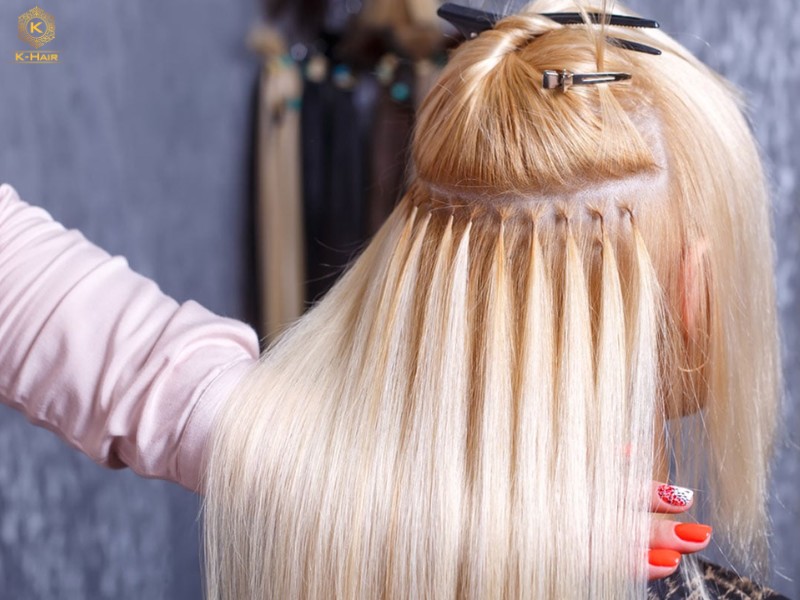
- Styling tips: high-heat styling is the number one enemy of hair extensions, as it can easily subject the hair to dryness, dehydration and damaged cuticles. Hence, before any heat styling, it is definitely recommended for all hair users and stylists out there to apply a layer of heat protectant, as well as avoiding direct heat on tape, keratin, or micro-ring bonds – as the ends of these extensions are extremely heat-sensitive and can even melt of break if come into contact with direct high heat. Additionally, daily high-heat styling is often to be avoided too, given its negative effect on hair health.
- Brushing & Detangling: detangling the hair is rarely a task you can ignore, as built-up hair tangles can cause extreme hair shedding and as hair users, you might have to sacrifice that tangled section of the hair by cutting it off permanently. Hence, to avoid such issues, hair users can apply the right combing method: using a soft-bristle or extension-specific brush; brushing the hair from ends to roots, avoiding going directly to the bonds/wefts; gently combing the hair – avoid using strong force; detangle before washing. By doing so, clients can minimize the threat of tangled, messy hair, while still reducing breakage during the detangling process.
- Washing: washing the hair extensions also demands extra care and consideration, given that there are many hair hygienic products that contain substances harmful or damaging for hair extensions. Using harsh products is one of the biggest factors reducing how long do hair extensions last. Hence, when shopping for hair shampoo or conditioner, make sure to check their ingredient list and make sure that they do not contain sulfate or other related substances. Furthermore, it is also highly suggested to wash the hair 2-3 times a week only to avoid losing too much natural hair oil can causing coarseness; condition the hair at mid-lengths to end only, avoid applying conditioners at the hair roots and attachment points; and rinse thoroughly to get rid of any residues and buildups.
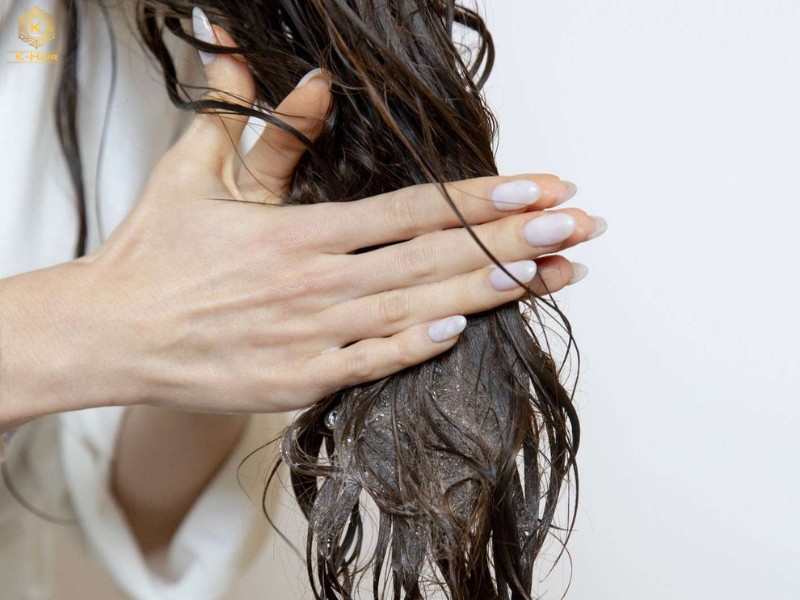
7. Human vs synthetic hair extensions: Lifespan & care comparison
To choose between human hair extensions and synthetic hair extensions has always been a difficult task, as both of these options tend to come with its own characteristics, perks and drawbacks.
To make the decision-making process easier, hair buyers can take references from our table below, describing the features and aspects of these distinct hair types:
| Human hair extension | Synthetic hair extension | |
| Lifespan | In terms of longevity, human hair extensions can last much longer than synthetic ones: Having its protective cuticle layers – human hair extension can last from at least 6-12 months and more → Can be used on the daily, make a more worthwhile long-term hair investment | Being made with plastic, synthetic hair can somewhat be considered a decent hair extension option, although it is much shorter-lasting than human hair: Last from 2-5 months only, under heat-styling, the lifespan would deteriorate even further to 1-2 months → Suitable for temporary use only, requires more frequent replacement |
| Appearance | Human hair is the go-to hair types if you are aiming for a natural look:
|
Modern synthetic hair can somewhat capture the natural shine of human hair, but it still comes short in many aspects:
|
| Styling ability | Human hair is highly versatile, given its intact cuticles and healthy state: Can be styled, cut, curled, or bleached and dyed to one’s liking → much like our own hair | Due to being made with plastic, synthetic hair can offer an extremely limited styling range:
|
| Durability | Thanks to having its full cuticles intact, human hair extensions is much more resilience than synthetic ones: Less prone to tangling, shedding → can be used for a longer than and provide more flexible styling options | The plastic fiber used to make the hair is extremely prone to tangling and shedding, especially when its outer coating layer is worn off → more prone to frizziness and hair shedding. |
| Care routine | Human hair often demands for higher maintenance:
|
One perks that synthetic hair have over human hair is that it is easier to manage: Synthetic hair is often pre-styled hence, it would always return to its original textures after hair use → easier to maintain. |
| Cost | Human hair extensions are often the more expensive investment, given that besides the intricate labour cost, buyers would also have to pay for the raw human hair material too. | Being made with plastic fiber also means that synthetic hair would be much cheaper than human hair – as these materials are much more widely available and accessible than the traditional raw human hair. |
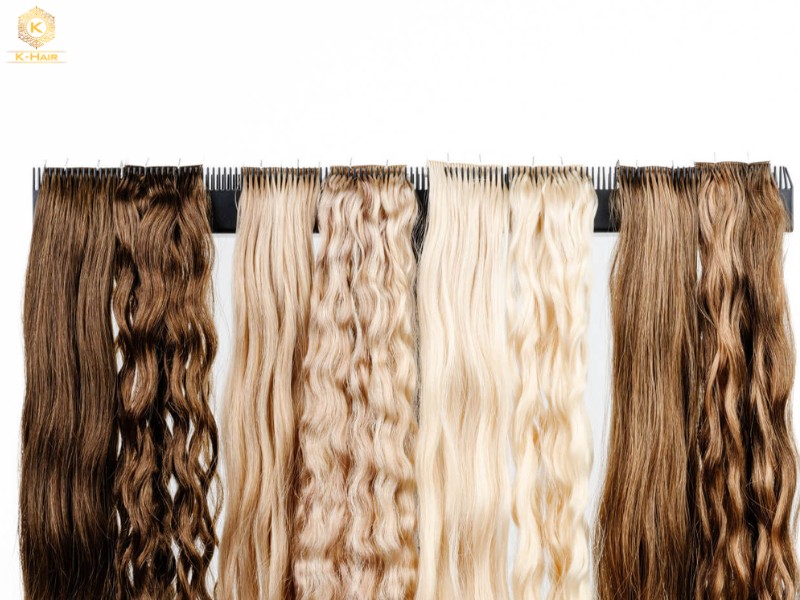
8. Conclusion
With the information provided in this article, we hope that we have managed to assist young women in the hair industry with the overall information, tips, and most importantly, how long do hair extensions last. Navigating through the complex hair industry requires long-term commitment and support from trustworthy partners, we proudly present ourselves not only as a trusted hair expert, but also a supportive friend who will always have your back in this somewhat overwhelming market.
Need to chat with a hair specialist? Contact us through the following link:
- Website: https://khairvn.com/
- Address: 10A, 171 Nguyen Ngoc Vu, Yen Hoa, Hanoi, Vietnam
- Phone: +8492 633 2545 (WhatsApp)
- Email: [email protected]
- Facebook: https://www.facebook.com/KHairFactoryVN/
- Youtube: https://www.youtube.com/c/KHAIRFACTORYBESTVIETNAMHAIR
- Whatsapp: +8492 633 2545

